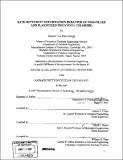Rate-dependent deformation behavior of poss-filled and plasticized poly(vinyl chloride)
Author(s)
Soong, Sharon Yu-Wen
DownloadFull printable version (43.98Mb)
Other Contributors
Massachusetts Institute of Technology. Dept. of Chemical Engineering.
Advisor
Robert E. Cohen and Mary C. Boyce.
Terms of use
Metadata
Show full item recordAbstract
Polymers are known to exhibit strong time-dependent mechanical behavior. In different temperatures or frequency regimes, the rate sensitivities of polymers change as various primary and secondary molecular mobility mechanisms are accessed. The incorporation of nanoparticles can potentially alter the molecular level structure of polymer, offering the opportunity to tailor the rate-dependent mechanical deformation and failure behavior of the polymer. This study focuses on polyhedral oligomeric silsesquioxanes (POSS) enhanced polymeric systems. POSS are hybrid organic-inorganic nano-scale molecules which consist of a silica cage with functional groups attached to the cage comers. Various binary and ternary polymer blends were produced by incorporating methacryl-POSS (C56I88,28Si8) (mPOSS) and dioctyl phthalate (DOP) into poly(vinyl chloride) (PVC) through melt blending. mPOSS was found to be miscible with PVC up to 15 wt% added. Both mPOSS and DOP plasticize PVC and reduce the [alpha]-transition temperature. While mPOSS also reduces the secondary ([beta]) transition temperatures in PVC, DOP was found to restrict the p-relaxation motions. (cont.) The rate-dependent yield and postyield behavior was characterized in compression testing over a wide range of strain rate (10-4/s to [approx.] 4000/s). Due to the geometric and size distinctions between the two molecules, mPOSS and DOP have different influences on PVC local molecular motions, resulting in dissimilar mechanical behavior. A clear rate-dependent sensitivity transition in yield was observed in the pure PVC and PVC/mPOSS blends in the intermediate strain rate regime, which is attributed to the need for stress-assisted activation of [beta]-motions at high strain rates. A transition in rate sensitivity was also identified in high DOP content compounds; this transition is due to the [alpha]-transition. The potential of using POSS as a plasticizer for PVC was evaluated. Through the use of ternary compositions, the proportion of mPOSS in PVC was increased substantially. The T8 of appropriately formulated ternary PVC/mPOSS/DOP compounds can be reduced to near room temperature, and these materials exhibit desirable ductile behavior. A constitutive model was used to predict the large deformation behavior of the PVC compounds. The two-process model is shown to capture the rate-sensitivity transitions in yield and the large deformation stress-strain behavior at low and high strain rates.
Description
Thesis (Ph. D.)--Massachusetts Institute of Technology, Dept. of Chemical Engineering, 2007. Includes bibliographical references.
Date issued
2007Department
Massachusetts Institute of Technology. Department of Chemical EngineeringPublisher
Massachusetts Institute of Technology
Keywords
Chemical Engineering.